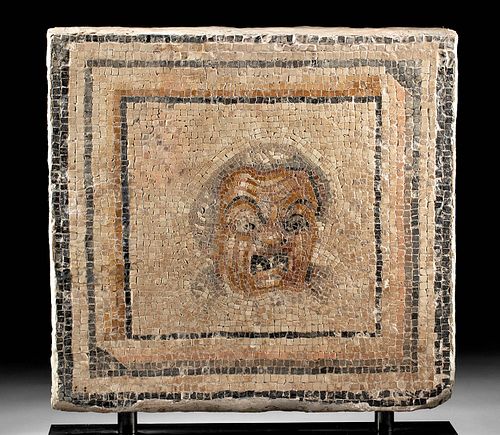Roman Mosaic w/ Mask of Hegemont Therapon
Lot 51b
About Seller
Artemis Fine Arts
686 S Taylor Ave, Ste 106
Louisville, CO 80027
United States
Selling antiquities, ancient and ethnographic art online since 1993, Artemis Gallery specializes in Classical Antiquities (Egyptian, Greek, Roman, Near Eastern), Asian, Pre-Columbian, African / Tribal / Oceanographic art. Our extensive inventory includes pottery, stone, metal, wood, glass and textil...Read more
Categories
Estimate:
$10,000 - $14,000
Absentee vs Live bid
Two ways to bid:
- Leave a max absentee bid and the platform will bid on your behalf up to your maximum bid during the live auction.
- Bid live during the auction and your bids will be submitted real-time to the auctioneer.
Bid Increments
| Price | Bid Increment |
|---|---|
| $0 | $25 |
| $300 | $50 |
| $1,000 | $100 |
| $2,000 | $250 |
| $5,000 | $500 |
| $10,000 | $1,000 |
| $20,000 | $2,500 |
| $50,000 | $5,000 |
| $100,000 | $10,000 |
| $200,000 | $20,000 |
About Auction
By Artemis Fine Arts
Feb 13, 2020
Set Reminder
2020-02-13 10:00:00
2020-02-13 10:00:00
America/New_York
Bidsquare
Bidsquare : Exceptional Antiquities, Asian, Ethnographic
https://www.bidsquare.com/auctions/artemis-gallery/exceptional-antiquities-asian-ethnographic-4848
An important one-day auction featuring museum-worthy examples of Egyptian, Greek, Roman, Etruscan, Near Eastern, Far East / Asian, Pre-Columbian, African / Tribal, Oceanic, Native American, Spanish Colonial, Russian, Fossils, Ancient Jewelry, Fine Art, so much more! Artemis Fine Arts info@artemisfinearts.com
An important one-day auction featuring museum-worthy examples of Egyptian, Greek, Roman, Etruscan, Near Eastern, Far East / Asian, Pre-Columbian, African / Tribal, Oceanic, Native American, Spanish Colonial, Russian, Fossils, Ancient Jewelry, Fine Art, so much more! Artemis Fine Arts info@artemisfinearts.com
- Lot Description
Roman, Imperial Period, ca. 1st to 2nd century CE. A very striking mosaic depicting a theater mask of "hegemon therapon" - an older, principal slave from Greek Comedy - surrounded by multiple nested borders - all comprised of stone tesserae of a plethora of neutral hues - various shades of beige, grey, russet, black, cream, umber, and more. The visage is delineated so skillfully, presenting an expressive countenance with numerous wrinkles above his furrowed brow and down his cheeks, severely cocked eyebrows, a scrunched up nose, an open mouth revealing just a few teeth, a tawny complexion, and a head of grey hair drawn away from his face. The artist demonstrated a wonderful command of the medium, using various sizes, shapes, and colors of stone tesserae to model the face so as to conjure three dimensions and capture light cast from his right, highlighting the tip of his nose and locks of his coiffure. This mosaic was most likely a medallion that joined a number of similar masks and surrounded a larger central image. Size: 20"" W x 19"" H (50.8 cm x 48.3 cm); 22"" H (55.9 cm) on included custom stand.
Mosaics (opus tesellatum) are some of our most enduring images from the Roman world, exciting not only for their aesthetic beauty, but also because they reveal what Romans chose to depict and see every day decorating their private and public spaces. As in Greece, masks played an important role in Roman theatre. An actor's entire head and hair would be covered by a large mask of simple design, made from linen or cork, with holes for the mouth and eyes. These masks allowed audience members seated in all areas of the theatre to understand what was happening, while also amplifying the actor's voice. The Pompeiian mosaic from the House of the Tragic Poet (now in the Naples National Archaeological Museum) shows several examples of these masks including one actor wearing an example pushed up on his head.
In the Roman province of Syria, which encompassed most of the ancient Near East/Levant, mosaics developed as a common art form relatively late, with most finds coming from the 3rd century CE or later. Syria was one of Rome's wealthiest provinces, but it was also far removed from Rome itself and Roman culture was overlaid on enduring cultural traditions from Hellenistic Greece and the great civilizations that came before it. Antioch-on-the-Orontes (modern day Antakya, Turkey), was the capital of northern Roman Syria, and its excavations in the 1930s revealed more than three hundred mosaic pavements - of which many embellished public baths. Popular mosaic themes from this region were often mythological or religious scenes, depicting gods and goddesses; however, sometimes mosaics were created to fit the theme of a building or room. This example may have been intended for a theatre. Romans appreciated all forms of entertainment and there were hundreds of playwrights in ancient Rome. Plays were performed to honor the gods during religious ceremonies, and since Rome had over 200 religious days of commemoration each year, plays were performed many days of the year.
Provenance: private East Coast, USA collection; acquired at Auctionata auction, Berlin, January 16, 2015, lot 118
All items legal to buy/sell under U.S. Statute covering cultural patrimony Code 2600, CHAPTER 14, and are guaranteed to be as described or your money back.
A Certificate of Authenticity will accompany all winning bids.
We ship worldwide and handle all shipping in-house for your convenience.
#153337Expected age wear with some abrasion, chips, and losses to tesserae as shown and a restorative treatment to the periphery. An overall finely executed example with fabulous optical effects.Condition
- Shipping Info
-
All shipping is handled in-house for your convenience. Your invoice from Artemis Gallery will include shipping calculation instructions. If in doubt, please inquire BEFORE bidding for estimated shipping costs for individual items.
-
- Buyer's Premium



 EUR
EUR CAD
CAD AUD
AUD GBP
GBP MXN
MXN HKD
HKD CNY
CNY MYR
MYR SEK
SEK SGD
SGD CHF
CHF THB
THB















